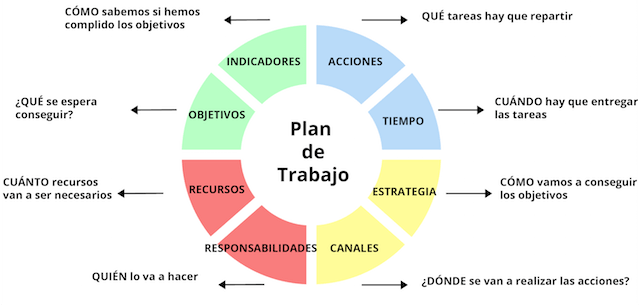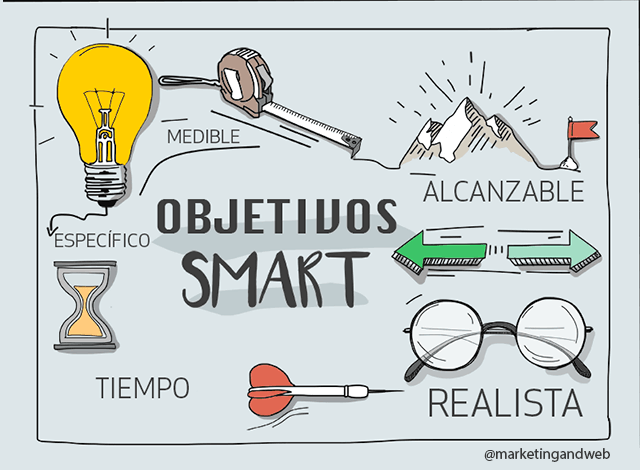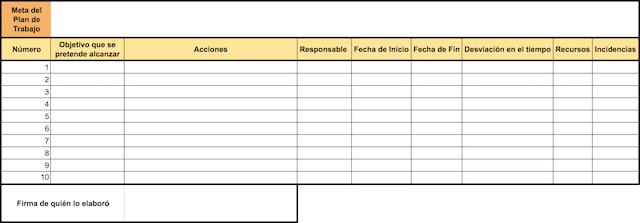I don't know if the term work plan will sound familiar to you, but if you have any type of business, do sales or are part of the academic field, you will know that organization is key.
This is where this term comes into play, because a work plan It is the scheme that will allow us to determine the tasks and outline who should do it and when.
It does not matter the size of your company and what you bill, you must have a work program to be able to effectively measure the actions taken.
Y este es mi target con este post, demostrarte how to make a simple work plan, to help you regardless of whether you dedicate yourself to academia or business.
What is a work plan and what is it for?
Before I start to tell you how to make a work plan, I have seen fit to clarify this concept first.
And it is that if I had to give a work plan term it would be the following:
A work program is an outline que sirve como hoja de ruta para tener en un único lugar todas las metas, procesos y tareas que debe de realizar una persona o equipo de persons para alcanzar unos objetivos determinados.
There are different types and examples of work plans, but they are usually applied to business, sales and studies.
And it serves mainly to know at all times the tasks to be carried out, when and by whom.
Objectives, characteristics and structure of a work plan
The main objective of a work plan It is to divide a complex or large procedure in order to divide it into small tasks, assigning it a period of time.
The idea is simple.
If we divide all the tasks that we have to carry out and assign them a period of time, we will be able to determine in a more orderly way how long it will take to achieve our objective.
To specify a little more, the main characteristics of a work plan we could say that they are:

<>
- WHAT tasks must be distributed: ACTIONS
- WHEN assignments must be delivered: TIME
- AS vamos a obtener los objetivos: ESTRATEGIA
- WHERE the actions will be carried out: CHANNELS
- WHO will do it: RESPONSIBILITIES
- MANY resources will be needed: HUMAN, TECHNOLOGICAL.
- WHAT it is expected to obtain (objectives).
- AS sabremos si hemos cumplido los objetivos: KPI
We could say that this is mainly the structure of a work plan and as a note, also clarify that they usually have a timeframe of one year.
Types and formats of a work plan
There are different types and formats of a work plan, but the most common are generally four:
- Sales work plan.
- Work plan of a personal project.
- Work plan of a company.
- Educational work plan.
Let's see a bit of what each of these formats consists of:
Sales work plan
It is very common for a company's sales team to have a work plan for each commercial.
Here coordination is important.
Think that each salesperson has specific sales objectives and specific areas to visit.
Thanks to the plan, not only can we know what are the tasks that each seller has, but it will also allow us measure the effectiveness of the sales force.
Work plan of a company
Cuanto mayor be la compañía, más serán los departamentos que están involucrados en la consecución de los objetivos.
Therefore, making a work plan for a company is important so that each department knows at all times what to do, what are your responsibilities, your deadlines and to whom you are accountable.
Work plan of a personal project
More and more people decide to start on their own and raise their own money to try to earn money online.
The problem is that they usually think that it is simpler than it seems and that it requires less effort than with a physical business.
Let me tell you that these are totally false, in most cases, marketing online is even more difficult than physically because we must work much more trust.
So organization and strategy become essential points for any entrepreneur and they need to know at all times what has to do and to when.
Educational work plan
At an academic level, making a work program for both teachers and students is essential for the proper functioning of the course.
In our case, we prepare them weekly, monthly and quarterly, but to keep a more exhaustive order of the fulfillment of all the tasks.
How to make a work plan step by step
And now, we are going to dive right in and see how to make a step-by-step work plan and all the phases that you should pay attention to.
If you remember, we have just seen all the items in the work plan, what we are going to do now is get into each of those points and see them in greater detail so that you have no doubts.
 1. What is the goal of your work plan?
1. What is the goal of your work plan?
Everything in life, and not only in marketing, must start from an objective.
What do we hope to obtain?
If we are not clear about where we want to go, it will be impossible to establish what steps must be taken to achieve it and therefore you will not be able to measure if you have reached it.
And believe me, everything that is not measured cannot be improved.
Your first step when preparing a work project is to be clear what do you want to get.
Of course, remember that regularly the different work plan examples are generally quarterly or annually.
 2. What is the work program about?
2. What is the work program about?
Regularly, when we make any type of report, be it an executive summary or a business plan, etc. you have to make one introduction where it is expressed in a simple way what does the work plan consist of.
Think that your program must be understandable by anyone who is part of the organization, so you should write some background put them in context.
Some tips for writing your introduction:
Clear and brief things are worth two.
You must make clear what your objective is with this plan and express the reasons why you created it.
What do you want to solve?
At the same time indicating the reasons why you have decided to create the program, you must also highlight what are the main problems you want to solve.
What was achieved previously?
It is not bad that you also make a mention of complaints, comments, claims and statistical data of previous work programs and indicate what you want to improve.
 3. What are your goals and objectives?
3. What are your goals and objectives?
Goals and objectives should be the compass that guides your plan and should reflect what you hope to achieve with it.
Of course, first of all, be clear about the main differences between goals and objectives.
The goals they tend to be established in a broader sense. That is, what we want to obtain in the future.
For example, a goal might be: "to get out of the competition in sales"
That is the desired state where we long to be.
While the objectivesThey try to divide that main goal into parts that will allow us to achieve and measure if we have achieved that goal.
Now, the objectives must follow a SMART structure, therefore we are going to see what that consists of in case you still do not know.

The SMART goals have to comply with the following structure:
Achievable: We must set some objectives that we can achieve, which is why it is essential to always establish what the action desired to obtain.
For example, it can be: increase X, decrease or decrease X, etc.
Measurable: To understand if we have achieved the objectives we must have an indicator that allows us to measure their achievement the degree of deviation.
For example, increase a 20% X.
There we are setting our indicator
Specific: We must also specify what we want to obtain.
Let's continue with the same example: increase a 20% sales of product A.
Realistic: It is useless to set a goal that we will not be able to achieve because it is too exaggerated.
So you must ask yourself that it is important that you know that it is ambitious but that you will be able to obtain.
Time: In conclusion, you must also determine a period of time for its achievement.
To finish the example, it would be as follows: Increase by 20% the sales of product A in the area of the Valencian Community in the next 6 months.
And from this dynamic we would have established our SMART objectives structure.
To make these two concepts clearer, here is an article where I show you different examples of goals and objectives of a company.
 4. What resources do you have at your disposal?
4. What resources do you have at your disposal?
This point is more important than you think.
To give you an idea, in my sector we usually think about many types of marketing strategies but when it is time to start planning, we realize that we do not have enough resources for their execution.
Here we must pay attention what is the work plan format we are talking about.
Labor sphere:
We have to pay attention physical resources such as the machinery or facilities that we will be able to own.
But also financial resources, that is, how much are we going to be able to invest.
And to finish resources at staff level, to understand how many people we will be able to count on.
Academic scope:
While in the academic area, the type of resources are the same but you have to know how to adapt it, that is, how many teachers we can count and for how many students.
How much material we will have at our disposal: PCs, tablets, books, etc.
 5. Who will be the responsible parties?
5. Who will be the responsible parties?
One of the parts of a work plan that you also have to pay enough attention to is the division of tasks.
Determine and correctly delineate who will be the people responsible for carrying out each of the tasks It can mark the success or failure of any project.
So you must make it very clear who or who or will be responsible for performing each task .
 6. What will be your strategy to obtain the objectives?
6. What will be your strategy to obtain the objectives?
Now we come to the most critical point of the work plan, the definition of the strategy that will allow us to achieve our objectives and goal.
Remember that when determining your strategy you have to be aware of the resources you have at your disposal and the execution period.
An unrealistic strategy that does not take these two items into account is going to be very difficult to succeed.
Recommendations when determining the strategy of your work program:
List all actions to be carried out:
- Segment the actions if they must be carried out on a daily, weekly or monthly basis.
- Segment the actions that each of the responsible persons must carry out.
Define a realistic schedule:
- Assign a run time to each of the tasks.
- It measures if they have been carried out in the expected time or if there are deficiencies.
In conclusion, I also suggest that you leave a time frame for unexpected situations.
Even when you have had to make a simple work plan, it is very very difficult for all the actions to be completed within the stipulated period of time.
There are always unforeseen events or complications that must be taken into account over time.
 7. Possible hindrances? Do you have a contingency plan?
7. Possible hindrances? Do you have a contingency plan?
This point is directly related to the last thing we have commented on.
There will always be obstacles at the time of execution.
What I suggest is that you take into account the examples of work plans made in previous periods of time and analyze what problems you had to face.
From this dynamic you will be able to determine a series of actions that can mitigate possible incidents and determine a contingency plan that allows you to achieve your objectives.
 8. Have the objectives been achieved?
8. Have the objectives been achieved?
A good work plan also has to pay attention to whether the desired objectives have been achieved.
The good thing about establishing well all the actions to be carried out and assigning the responsible persons and the determined period of time is that it will allow us analyze those items in which we have not fulfilled what was foreseen.
Analyzing this data and collecting the feedback from all the actions, what we have to do is take it into account when creating future work plans. take the appropriate measures.
But if we do not measure it, it will be impossible to truly know if everything has worked as planned, which is why it is so important to establish the SMART goal structure mentioned above.
Example of a work plan
So that you can get a more realistic idea of what a work plan is like, I wanted to show you a template that I think will help you a little more to visualize it.
In the end, it is to take all the points that we have been mentioning throughout the post and join them in a roadmap that allows their implementation and measurement.

Of course, this is an example of a work plan that I propose to you, but you do not have to follow it strictly.
In the end, you must adapt it to your own project, whether at a sales, business, or academic level.
But whatever your type of project, always remember when you must start from an objective and assign it an execution period, a series of actions and the respective responsibilities.
Tips when preparing a work plan
In conclusion, I would like to give you a series of tips when preparing your work program.
Even though I have already mentioned many of them throughout the post, I have seen fit to collect them at a single point so that you have them better identified.
- ALWAYS define SMART goals so you can measure results.
- Analyze in depth the resources that you are going to possess.
- Delimits very well the responsibilities and tasks of each of the people.
- Define a margin of time deviation in case unforeseen events arise.
- Establish a contingency plan in case the objectives are not being met.
- It measures all the actions that have been carried out and their deviation.

![Cómo hacer un Plan de Trabajo sencillo paso a paso [Ejemplos]](https://rmarketingdigital.com/wp-content/uploads/2020/11/plan-de-trabajo-8596587.png)





